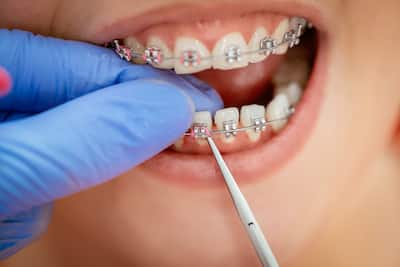![]() VERIFIED
VERIFIED

As suggested by Dr Ekta Khatri there are 4 options for straightening your teeth, 1) Conventional braces, 2) Clear aligners 3) Veneers or crowns 4) Dental bonding.
One of the common concerns of patients these days is the misalignment of teeth, usually due to cosmetic reasons. For dentists, it’s also a cause for concern from the functional aspect. Understanding why the teeth are not aligned in the most ideal way is of prime importance before planning a treatment. Habits like thumb sucking, tongue thrusting, or traumatic injury to the jaw, jaw size, poor nutrition and genetics all have been known to impact the alignment of teeth. Misalignment of teeth can cause spacing between teeth, crowding, change in facial aesthetics and improper occlusions like a deep bite, crossbite, open bite and overbite. All these problems have been associated with difficulties in maintaining oral hygiene.
The Benefits Of Straightening Teeth
They have a long-term effect on oral health and improve speech, function and aesthetics. As dentists, we give all options to straighten teeth; however, the best choice depends on your lifestyle and budget. Keeping that in mind, there are options for straightening your teeth, as suggested by Dr Ekta Khatri- Co-Founder of The Func Dent – The Functional Dentistry Center, Prosthodontist and Implantologist.
- Conventional braces- these can be metal or ceramic brackets connected with a wire and placed on the surface of your teeth that is labial (facing the lip) or lingual (facing the tongue). This is the most common and most traditional method of aligning teeth. They straighten teeth by applying pressure on the teeth slowly, allowing movement; the dentist often carries this out. Generally, braces take a year to three years to straighten teeth. The patient requires immaculate oral hygiene maintenance during this time.
- Clear aligners- the newer, more popular option, are custom trays designed to move the teeth in a desirable position. They are a more preferred option these days as, unlike traditional braces, they are much less noticeable; they can be removed while eating and brushing, making maintenance very easy. However, they are more expensive.
- Veneers or crowns are prosthetics that do not move the natural teeth but involve shaving and shaping the teeth and placing thin shells (veneers) or full coverage crowns over them for a more aligned appearance. They are usually done when a person wants to change their natural teeth’ alignment, shape, size and colour. Full coverable crowns are seldom done these days as they require a significant reduction in tooth surface.
- Dental bonding- another procedure that does not move the teeth but is done by bonding tooth-coloured resin onto the surface of the teeth, giving the appearance of teeth being aligned. However, it is not a long-term solution; the wax can get discoloured and chip or break if the bite needs to be corrected.
If you are considering straightening your teeth, you must visit your dentist for the most appropriate treatment option, as factors such as severity of misalignment, age and lifestyle impact the outcome.
READ RELATED: Target Now Sells Fancy Organic Steaks
Total Wellness is now just a click away.
Follow us on
Don’t Miss Out on the Latest Updates.
Subscribe to Our Newsletter Today!
window.addEventListener(‘load’, (event) => {
$(‘#commentbtn’).on(“click”,function(){
(function(d, s, id) { var js, fjs = d.getElementsByTagName(s)[0]; if (d.getElementById(id)) return; js = d.createElement(s); js.id = id; js.src = “//connect.facebook.net/en_US/sdk.js#xfbml=1&version=v2.3”; fjs.parentNode.insertBefore(js, fjs);}(document, ‘script’, ‘facebook-jssdk’));
$(“.cmntbox”).toggle();
});
});








